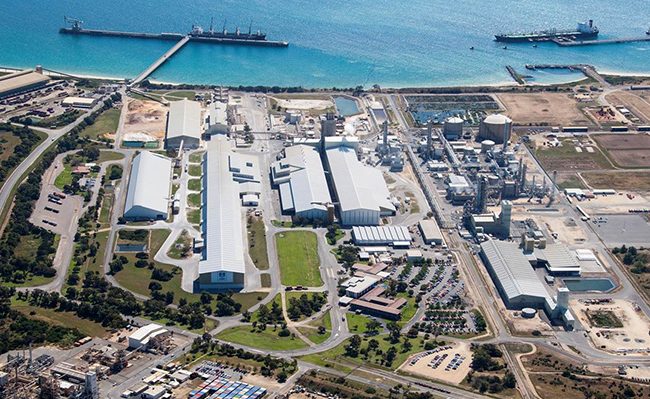WesCEF is one of 18 of Australia’s largest companies backing research that says an 88% cut to heavy industry emissions is possible and would set up key regions for the net zero transition.
Major industrial regions – including the Pilbara, Kwinana, Hunter, Illawarra and Gladstone – have the natural resources, workforce and baseline infrastructure that can be expanded to support Australia’s net zero transition, according to a report released today.
The report shows it is possible for these five regions to achieve an 88 percent reduction in their current emissions, which together account for about one-eighth of Australia’s total emissions. This is the equivalent to 70 MtCO2e of abatement, or to removing all emissions from cars and light commercial vehicles across Australia.
The ‘Setting up industrial regions for net zero’ report is the result of a two-year collaboration between some of Australia’s largest companies, as part of the Australian Industry Energy Transitions Initiative (Australian Industry ETI), which is entering its final phase. It was prepared for the Australian Industry ETI by not-for-profits Climateworks Centre, based at Monash University, and Climate-KIC Australia, which are co-conveners of the initiative.
The report shows that industrial regions can contribute to reaching state and national net zero emissions targets by 2050, while driving employment growth and building Australia’s climate resilience.
The Australian Industry ETI brings together key industry and finance participants to accelerate action towards achieving net-zero emissions in supply chains by 2050, across critical sectors known as ‘hard-to-abate’ given their high emissions and relatively higher abatement costs.
The 18 initiative participants represent approximately 27 percent of the ASX100 market value. They include Australian Gas Infrastructure Group, APA Group, Aurecon, AustralianSuper, BHP, BlueScope Steel, bp Australia, Cbus, the Clean Energy Finance Corporation, Fortescue Metals Group, HSBC, Orica, National Australia Bank, Rio Tinto, Schneider Electric, Wesfarmers Chemicals, Energy & Fertilisers (WesCEF), Westpac and Woodside Energy.
WesCEF Managing Director Ian Hansen said WesCEF has a longstanding presence in Kwinana where a strong legacy of collaboration across industries already exists.
“As an emissions-intensive industrial region, collectively pursuing decarbonisation opportunities is a natural next step and the ETI Phase 2 report will be a crucial enabler in facilitating this collaboration,” Mr Hansen said.
The Australian Industry ETI focuses on reducing supply chain emissions across five sectors: iron and steel; aluminium; LNG; other metals, including copper, nickel, lithium; and chemicals, such as fertilisers and explosives.
‘Through this analysis of the decarbonisation potential of five important industrial regions where Australian Industry ETI participants are active, we have gained invaluable insights into the opportunities and on-the-ground challenges in the net zero transition,’ said Australian Industry ETI Chair, Simon McKeon AO, Chancellor of Monash University, former CSIRO Chairman and former Australian of the Year.
‘Australia can remain competitive in a decarbonising global economy. But this will require coordinated efforts across industry, governments and communities and also the finance and energy sectors. It will also need the alignment of policy, regulations and programs to create clear goals and investment confidence.’
The report finds Australia’s industrial regions can capitalise on global demand for low-carbon products and energy exports.
‘This is achievable if we rapidly deploy existing technology solutions, and support the development and demonstration of emerging opportunities through more proactive regional coordination and collaboration,’ said Climateworks CEO Anna Skarbek.
The report reveals the scale of renewable energy required to decarbonise five industry supply chains in the Pilbara, Kwinana, Hunter, Illawarra and Gladstone would be an additional 25-47 percent of Australia’s total electricity generation, or 68.3 to 125.9 TWh of energy.
‘This will require an unprecedented transformation of the energy system,’ said Ms Skarbek. ‘Governments will have a significant role to play in achieving this, with supportive policy, programs and support for regional leadership efforts, especially in infrastructure which is an enabler of decarbonisation.’
The required renewable energy infrastructure, green hydrogen and energy storage has the potential to create job opportunities for 178,000 to 372,000 Australians. The investment in these regions and enabling infrastructure will be in the order of $50 to $100 billion, the report finds.
Targets for industrial regions can facilitate planning and action, and guide decision making for the long-term transition. This, as well as coordinated planning and development of multi-user infrastructure and the co-development of regional decarbonisation roadmaps, are among the report’s recommended actions.
The formation of clustered industrial precincts is a key opportunity for Australian industry and in regions where hard-to-abate sectors are concentrated.
‘Australia’s industrial regions make an enormous contribution to the economy and are hugely significant in terms of jobs and identity. The regions we studied already have the industries, concentration of energy demand, investment, ports, industry knowledge and skills we need for Australia to thrive through the transition,’ said Chris Lee, Climate-KIC CEO.
‘This is because precinct-scale responses present opportunities to leverage multi-user infrastructure and existing workforce skills, and more effective use of transmission, distribution and storage infrastructure, which drives emissions down.’
The Australian Industry ETI is run by independent not-for-profits Climateworks and Climate-KIC, in collaboration with the global Energy Transitions Commission. Its knowledge partners include CSIRO, Rocky Mountain Institute and BloombergNEF. It is funded by philanthropy, company contributions and the Australian Government through the Australian Renewable Energy Agency’s (ARENA) Advancing Renewables Program.
With momentum building across Australia’s economy to decarbonise, the next phase of the initiative will focus on setting decarbonisation pathways for Australia’s industrial supply chains, in line with the global goal of limiting global warming to 1.5 degrees Celsius.
‘Setting up industrial regions for net zero: A guide to decarbonisation opportunities in regional Australia’ will be published on 20 June 2022 and available online at www.energy transition initiative.org.

